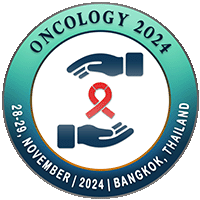
Adil Abdulzhaliev
Blokhin Oncology Center, RussiaTitle: Peripheral nerve sheath tumors: expression of PD-L1, PU.1 and results of surgical treatment
Abstract
Introduction. Malignant tumors from the membranes of peripheral nerves (MPNST) are a rare heterogeneous group of aggressive neoplasms of soft tissue sarcomas (STS), for which the relationship between the level of PD-L1 expression with the clinical behavior and outcome of the disease has not yet been determined. Loss of function of NF1, TP53, and CDKN2A genes is thought to contribute to the progression of benign neurofibroma to PNSM and is a poor prognostic sign. In addition, with respect to solid tumors, the role of tumor microenvironment, in particular tumor-associated macrophages, remains unexplored. The optimal management of patients with this disease is currently unresolved, and specific prognostic factors have not been established. The aim of the study: to evaluate the degree of influence of PD-L1 expression, as well as the nuclear marker of PU.1 in stromal cells as well as on general (OS) and recurrence-free survival (RFS) in patients with malignant peripheral nerve sheath tumors. Materials and methods. The retrospective study included 61adult patients-38 (62%) females and 23 (38%) males, with malignant peripheral nerves sheath tumors who were surgicaly or combined treated in the period from 1998 to 2022 at the N.N. Blokhin Oncology Research Center. The analysis of clinical and morphological parameters was carried out, the results of surgical treatment were studied. The expression of PD-L1, PU.1 and Ki-67% was analyzed by immunohistochemical (IHC) method. The most common PNSM localization was paravertebral (22 [36%] patients), followed by retroperitoneal (14 [23%] patients), and upper and lower extremities (13 [21%] and 12 [20%] patients, respectively). Results. Positive staining for PD-L1 was observed in 28% of cases. PU.1 expression was observed in all samples studied. There was a statistically significant correlation between the expression level of PU.1 and PD-L1. At a median follow-up of 37 months, PD-L1 positive status was associated with a lower median OS and RFS in the group of patients with grade III tumors (p=0,0003 and p-0,004, respectively). The median OS for tumors with high and low number PU.1+ cells was 21 and 78 months, respectively (p<0,0001).Median OS for grade 1 malignancies was not achieved, while grade 2 and grade 3 malignancy was 53 and 33 months, respectively (p=0.033). The median RFS for grade 1, 2, and 3 tumors was 119, 43, and 15 months, respectively (p=0.078). Patients who underwent radical (R0) surgery had higher RFS (p=0.006) and OS (p<0.0001). After radical (R0) surgery, the median OS was not achieved; after nonradical (R1/R2) surgery, the median was 34 months. The median RFS was 124 months after R0-resection and 48 months after R1/R2. Conclusion. The study describes for the first time the prognostic value of the macrophage marker PU.1 in patients with MPNST. High level of content PU+1+ cells, regardless of the degree of malignancy, as well as the expression of PD-L1 >1% in patients with low-grade tumor, significantly negatively affected OS and FRS. The results obtained make it possible to use the analysis of the expression of these markers as prognostic, and also, probably, for the development of new therapeutic possibilities. The most significant prognostic factors in PNSM patients are the radicality of the surgery performed and the malignancy grade. In our study, tumor size and localization did not affect the long-term treatment results
Biography
Adil Abdulzhaliev is last year PHD student from Blokhin Oncology Research Center, Moscow, Russia. He is a surgery oncologist of Scientific and practical center of bone and soft tissue tumors, Moscow, Russia. He published 6 scientific papers in domestic and foreign publications.

